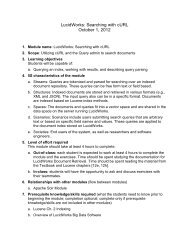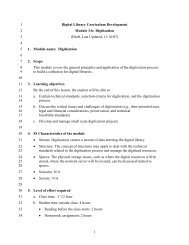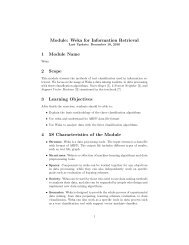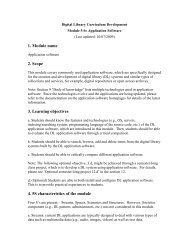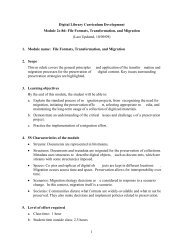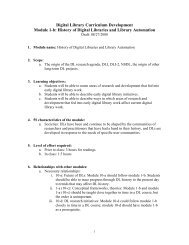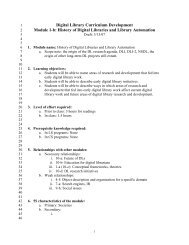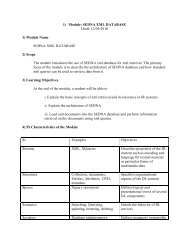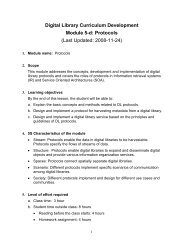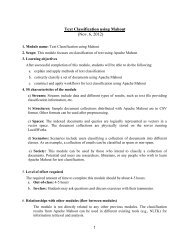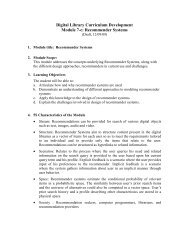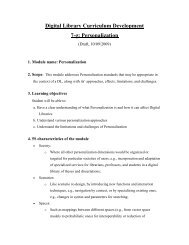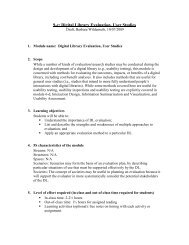Template for DL Instructional Modules - Digital Library Curriculum ...
Template for DL Instructional Modules - Digital Library Curriculum ...
Template for DL Instructional Modules - Digital Library Curriculum ...
Create successful ePaper yourself
Turn your PDF publications into a flip-book with our unique Google optimized e-Paper software.
6-a: In<strong>for</strong>mation Needs, RelevancePage 8Schamber, L., Eisenberg, M.B., & Nilan, M.S. (1990). A re-examination of relevance:Toward a dynamic, situational definition. In<strong>for</strong>mation Processing & Management,26(6), 755-776.Swanson, D.R. (1986). Subjective versus objective relevance in bibliographic retrievalsystems. <strong>Library</strong> Quarterly, 56(4), 389-398.Wang, P., & Soergel, D. (1998). A cognitive model of document use during a researchproject. Study I. Document selection. Journal of the American Society <strong>for</strong>In<strong>for</strong>mation Science, 49(2), 115-133.Wilson, P. (1973). Situational relevance. In<strong>for</strong>mation Storage & Retrieval, 9(8), 457-471.Yuan, X.-J., Belkin, N. J., & Kim, J.-Y. (2002). The relationship between ASK andrelevance criteria. Proceedings of SIGIR 2002, 359-360.11. Concept MapNone12. Exercises/Learning Activitiesa. Discussion activity: Personal experiences of an in<strong>for</strong>mation need (25 minutes)To follow the review of Wilson’s generalized model of in<strong>for</strong>mation behaviorStudents in the class should be <strong>for</strong>med into pairs. In each pair, one student willinterview the other. (This process should later be repeated, reversing roles.) Theperson being interviewed should be asked to recall a recent experience of havingan in<strong>for</strong>mation need. The need may have been something significant (e.g.,finding sources to use <strong>for</strong> a research project) or something inconsequential (e.g.,finding the start time <strong>for</strong> Saturday’s football game). The interviewer should askabout the content of the in<strong>for</strong>mation need, the context in which it arose, and theprocess through which it was pursued (successfully or unsuccessfully). The pairshould then evaluate what was learned about this example of an in<strong>for</strong>mation needand see if Wilson’s model fully describes the process. Were there aspects of thein<strong>for</strong>mation-seeking episode that are not covered in Wilson’s model? Are thereaspects of Wilson’s model that did not occur during this in<strong>for</strong>mation-seekingepisode?b. Brainstorming/discussion activity: Observable indicators of an in<strong>for</strong>mation need(20 minutes)To follow discussion of Taylor’s levels of needs, or at the end of the class periodAn in<strong>for</strong>mation need is experienced in an individual’s consciousness. But at somepoint, if the person decides to pursue it, there are observable indicators that a needhas been experienced.Form the students into small groups of 2-3 people. Each group should get 10minutes to brainstorm as many indicators of in<strong>for</strong>mation needs as possible. Theymay include those they’ve observed, those they’ve enacted, or others they canimagine.



